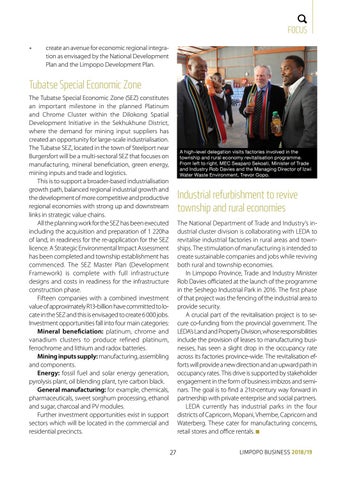FOCUS •
create an avenue for economic regional integration as envisaged by the National Development Plan and the Limpopo Development Plan.
Tubatse Special Economic Zone The Tubatse Special Economic Zone (SEZ) constitutes an important milestone in the planned Platinum and Chrome Cluster within the Dilokong Spatial Development Initiative in the Sekhukhune District, where the demand for mining input suppliers has created an opportunity for large-scale industrialisation. The Tubatse SEZ, located in the town of Steelport near Burgersfort will be a multi-sectoral SEZ that focuses on manufacturing, mineral beneficiation, green energy, mining inputs and trade and logistics. This is to support a broader-based industrialisation growth path, balanced regional industrial growth and the development of more competitive and productive regional economies with strong up and downstream links in strategic value chains. All the planning work for the SEZ has been executed including the acquisition and preparation of 1 220ha of land, in readiness for the re-application for the SEZ licence. A Strategic Environmental Impact Assessment has been completed and township establishment has commenced. The SEZ Master Plan (Development Framework) is complete with full infrastructure designs and costs in readiness for the infrastructure construction phase. Fifteen companies with a combined investment value of approximately R13-billion have committed to locate in the SEZ and this is envisaged to create 6 000 jobs. Investment opportunities fall into four main categories: Mineral beneficiation: platinum, chrome and vanadium clusters to produce refined platinum, ferrochrome and lithium and radox batteries. Mining inputs supply: manufacturing, assembling and components. Energy: fossil fuel and solar energy generation, pyrolysis plant, oil blending plant, tyre carbon black. General manufacturing: for example, chemicals, pharmaceuticals, sweet sorghum processing, ethanol and sugar, charcoal and PV modules. Further investment opportunities exist in support sectors which will be located in the commercial and residential precincts.
A high-level delegation visits factories involved in the township and rural economy revitalisation programme. From left to right, MEC Seaparo Sekoati, Minister of Trade and Industry Rob Davies and the Managing Director of Izwi Water Waste Environment, Trevor Gopo.
Industrial refurbishment to revive township and rural economies The National Department of Trade and Industry’s industrial cluster division is collaborating with LEDA to revitalise industrial factories in rural areas and townships. The stimulation of manufacturing is intended to create sustainable companies and jobs while reviving both rural and township economies. In Limpopo Province, Trade and Industry Minister Rob Davies officiated at the launch of the programme in the Seshego Industrial Park in 2016. The first phase of that project was the fencing of the industrial area to provide security. A crucial part of the revitalisation project is to secure co-funding from the provincial government. The LEDA’s Land and Property Division, whose responsibilities include the provision of leases to manufacturing businesses, has seen a slight drop in the occupancy rate across its factories province-wide. The revitalisation efforts will provide a new direction and an upward path in occupancy rates. This drive is supported by stakeholder engagement in the form of business imbizos and seminars. The goal is to find a 21st-century way forward in partnership with private enterprise and social partners. LEDA currently has industrial parks in the four districts of Capricorn, Mopani, Vhembe, Capricorn and Waterberg. These cater for manufacturing concerns, retail stores and office rentals.
27
LIMPOPO BUSINESS 2018/19
